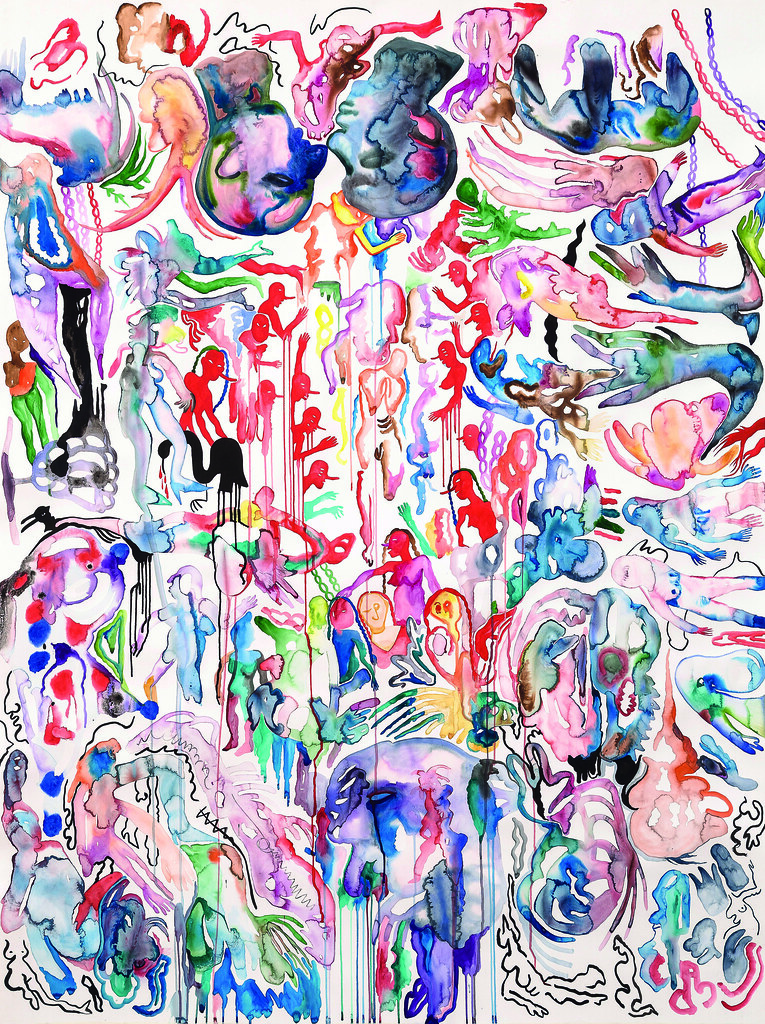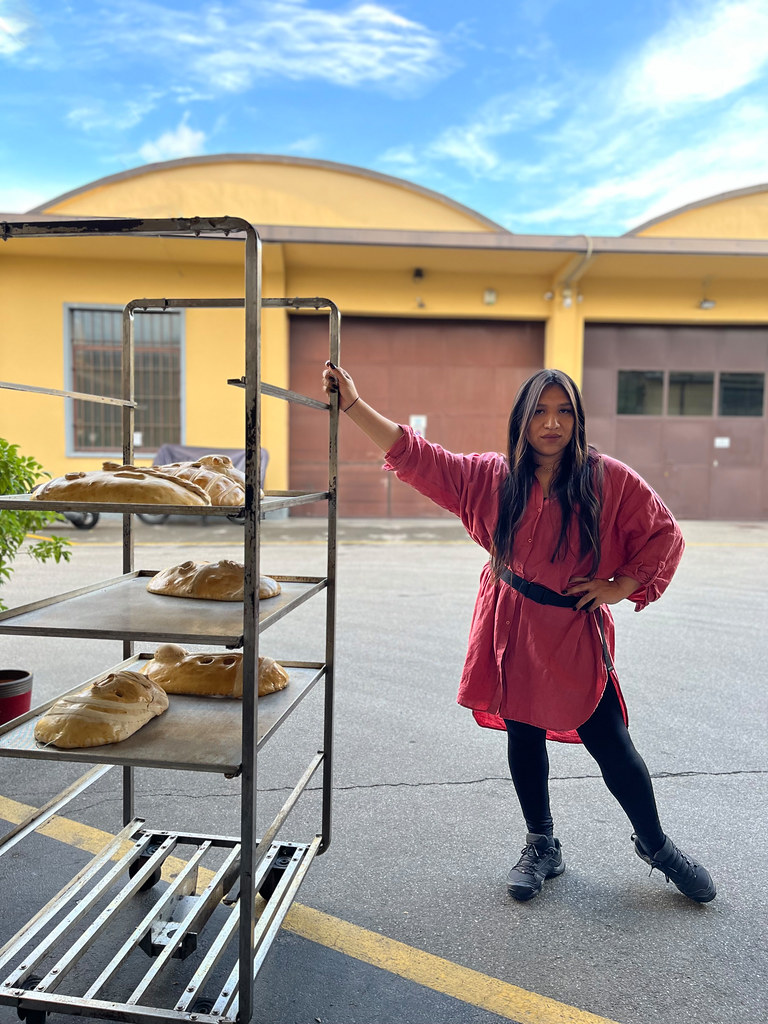Guaymallén is a small town in northwestern Argentina, at the foot of the Andes mountain range. That’s where artist, performer and LGBTQ+ rights activist La Chola Poblete grew up. Surrounded by indigenous heritage, catholic rituals, comics, rock music and strong women.
She recently had a cheerful and rather magnificent solo exhibition at MUDEC, The Museum of Cultures of Milan, titled La Chola Poblete – Guaymallén.
La Chola Poblete in front of flag that says: ‘I am an undesirable body but here I am’. Installation view at MUDEC, Milano, 2024. Photo: Jule Hering
La Chola Poblete, Virgen del Carmen de Cuyo
La Chola critically examines the repercussions of colonialism, forced evangelisation and white supremacy in her homeland. Her work challenges stereotypes and exoticising of indigenous cultures. It re-appropriates religious figures, dismantles cultural hierarchies and plays with historical icons to give them a queer, indigenous but ultimately broader and more modern dimension.
The show transformed the exhibition rooms into a spiritual space where religious, political, erotic, pop-cultural and indigenous motifs and symbols mix together and challenge entrenched dogmas. La Chola tells stories of salvation, virgins, pop heroes, martyrs, ancient goddesses and gender-bending beings.
Her work is biting but never aggressive. It is satirical, but in a gentle, humorous and thoughtful way.
La Chola Poblete, Virgen de la leche, 2023
La Chola’s performances, large-scale watercolours and sculptures shed light on how religious and patriarchal ideologies have stigmatised expressions of femininity and how women, transvestites and transsexuals have resisted and pushed back against these forms of ostracism.
She uses the figure of the Virgin Mary, for example, to represent the syncretism between christianity and indigenous cultures. For her, the Madonna is a mother, a woman, a saint, a temptress, a pop icon and even Pachamama, the Earth Mother revered by the Andean communities.
As La Chola explained to Exibart, “The Virgin Mary can be so many versions of herself, she can be a mother, a whore, a woman and everything she wants. She is the only woman who can be who she wants to be. For me, she is very contemporary. She also is also a bit of a transvestite, with the wig, the dresses and her multiple images. She is the best drag queen in history.”
The Virgen de la leche is a Nursing Madonna giving her breast, not to the baby in her arms, but to a Mormon missionary, a member of a religious group with a growing following in Argentina. The work talks about the church’s history of racial discrimination.
La Chola Poblete, Maria & papas lays, 2022. Installation view at MUDEC, Milano, 2024. Photo: Jule Hering
Example of a virgen para vestir/Virgin to dress up
A Madonna stands in the middle of a circle of potato chips. The sculpture is inspired by the vírgenes para vestir (Virgins to dress), statues of the Virgin Mary that worshippers can dress up according to the Catholic liturgy and processions in the calendar.
The lower part of the saintly figure is made of wood. Her face and torso are sculpted from baked bread. Like Saint Sebastian, La Chola Poblete’s Virgin has been shot with arrows. In this case, the arrows are decorated with Indigenous symbols. Yet, the Madonna remains tranquil.
As for the potato chips, they are meant to evoke colonisation. The potato, once rejected by the colonisers because it was unknown and grew under the soil (and thus was considered an evil food), has now become the Western world’s favourite junk food.
La Chola Poblete, installation view at MUDEC, Milano, 2024. Photo: Jule Hering
Another virgin was laid like one of the anatomical wax women that were used in the 18th century by students to study the human body.
The figure was made of bread. Her internal organs were represented by a vase and shapes made of bread too, alluding to the hybridisation of indigenous and Catholic cultures, but also to alternative methods of reproduction.
La Chola likes working with dough because it takes a life of its own. The shapes and shades of the final figure depend on the quality of the dough, the quantity of yeast and how long it remains in the oven. After the baking process, the bread continues to evolve, it dries up or gets mouldy depending on the environment.
In an interview with Clarin, La Chola Poblete declared, “I want to be an artist and I often wonder if they take me seriously or if I’m just a fad.” After all, she ticks all the boxes: brown, queer, indigenous. But i doubt her success is just an effect of tokenism. Her universe is fascinating, her artistic techniques and ideas are like none i’ve seen before and i certainly hope to see more of her work around Europe in the coming years.
More images from the exhibition:
La Chola Poblete, Virgen de la Carrodilla
La Chola Poblete, Barroco Andino, 2023
La Chola Poblete, installation view at MUDEC, Milano, 2024. Photo: Jule Hering
La Chola Poblete, installation view at MUDEC, Milano, 2024. Photo: Jule Hering
La Chola Poblete, installation view at MUDEC, Milano, 2024. Photo: Jule Hering
La Chola Poblete – Guaymallén. Opere di Pane. Photo: Davide Longoni
La Chola Poblete – Guaymallén. Opere di Pane. Photo: Davide Longoni
Intro by curator Britta Färber, La Chola Poblete: Guaymallén (EN Subtitles)
The exhibition La Chola Poblete – Guaymallén, curated by Britta Färber, closed a few weeks ago at https://www.mudec.it/ in Milan. The show accompanied Deutsche Bank’s Artist of the Year award that La Chola Poblete received in 2023. La Chola Poblete’s work is also part of Stranieri Ovunque. Foreigners Everywhere at the Venice Art Biennial which remains open until 24 November 2024.















